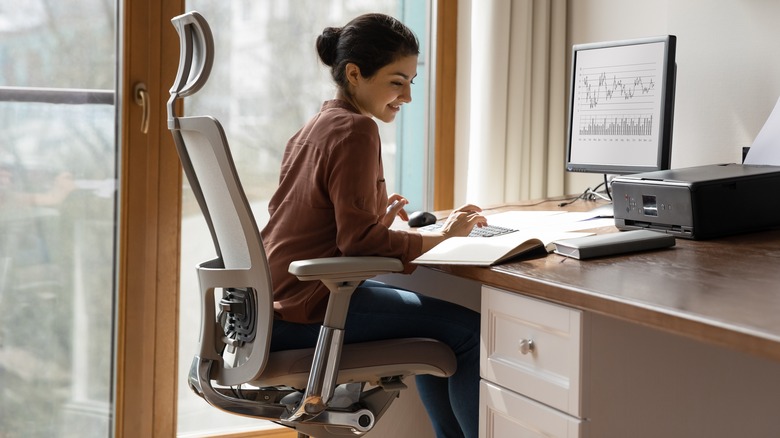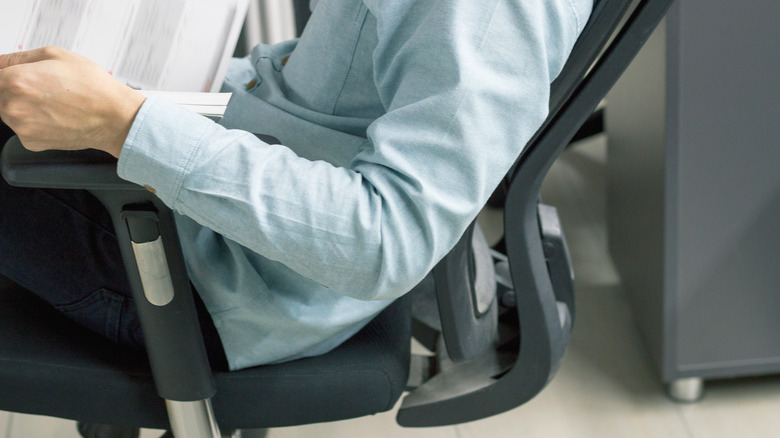Drafting Chairs Vs. Ergonomic Chairs: What's The Difference?
Working from home has become more popular than ever and having the right gear is key to a quality experience (via Autonomous). In addition to the right location and computer setup, your desk and chair are an important part of working comfortably in any office.
From gaming to having Zoom calls all day, office chairs have evolved into different types that meet different needs. The perfect desk chair takes work to find but makes whatever you're doing so much better when you find it. When choosing an office chair, customization and adjustability are key; getting a chair that fits your body's dimensions will ensure that you are as comfortable and safe as possible.
A drafting chair is a modern version of the traditional office chair that is made to fit tables that are taller than the average desk. An ergonomic chair gets its name from the discipline of ergonomics, which focuses on creating objects to be best-suited for human use, per ChairOffice. Both chairs serve different populations; knowing what they offer will really help in choosing the right chair to meet your needs.
How does the composition differ?
In making a decision about the chair you want, its height and features will play an important role, as noted by the Chair Institute. You'll have to think about the height of your desk or table and how well the chair can adjust to fit it. Its adjustment capability is important because it should be flexible in terms of how high and low it can go, how the back tilts, and how the footrest can be set.
The main purpose of a drafting chair is to have an adjustable height and provide support to people that need to lean forward while sitting down. It doesn't always come with armrests but always includes a footrest. It can also go all the way up to 25 to 35 inches in height (via Office Chair Trends). For reference, a basic office chair is around 17 by 20 inches, per Office Chairs Unlimited.
Ergonomic chairs are intended to meet your needs, which is why they include multiple adjustable features, from lumbar support to back, arm, and headrests, says Office Chair Trends. It should also allow you to have your feet flat on the floor and let you shift comfortably in your seat.
Pros and cons of drafting chairs
Because of their taller height, standard office desks might not accommodate drafting chairs very well. This means that they won't be the kind of chairs you can take back and forth between your home and your office unless their adjustment levels in terms of height, armrests, and other features fit your office desk.
Drafting chairs are usually affordable because their main feature is the adjustable height and they don't always offer all the other types of adjustments. If you're someone with a job that involves more movement at a desk than is usual, this is a great fit for you. It provides all the support and flexibility you might need while sitting, moving, and bending forward for long hours at work, per Architecture Chat. If you've caught the new wave of standing desks, a drafting chair will also be a good option for you because it pairs very well with standing desks.
Pros and cons of ergonomic chairs
Ergonomic chairs are designed for better posture, specifically with backrests that support the spine's natural S shape. They are also known for their durability. If you are at your desk for most of your day, this is a good investment in your work life. There's also something for everyone. Whether you want thick padding or light mesh, you can get a chair that fits the weather, your design wants, and even the aesthetic of the environment it's going to be in. A quality ergonomic chair will have a seat that can tilt, which lets you keep your pelvis in the correct position while sitting down, according to Chair Office.
Because of the research and development that goes into their creation, it's not surprising that ergonomic chairs are on the expensive side when it comes to office chairs (via Egyptian Workspace Partners). If you don't have a lot in your budget and you need a new chair, this might not be the easiest option for you to choose due to the costs.
When to choose a drafting chair or an ergonomic chair
Drafting chairs are popular for designers, architects, and other professionals that spend a lot of time working at a table or desk. For those outside this category, you can think about what you'll be using your drafting chair for and how. Will you need to move around a lot? If so, then a light, drafting chair that has wheels will be a good fit. Do you need space while you move around your workspace? Consider a drafting stool or chair without arms.
Lumbar back support is important when sitting because it fills in the gap between the lower back region of the spinal column and the seat, where there is a natural inward curve of the lower back, shares Beyond the Office Door. Drafting chairs are usually missing this type of support, while ergonomic chairs are made for this because they are crafted with the design of the human body in mind (via Chair Office). For those battling pain in the neck, shoulder, or lower back, ergonomic chairs can provide relief. Their costs also provide assurance that you are getting lasting quality and won't need to switch out your chair anytime soon.




